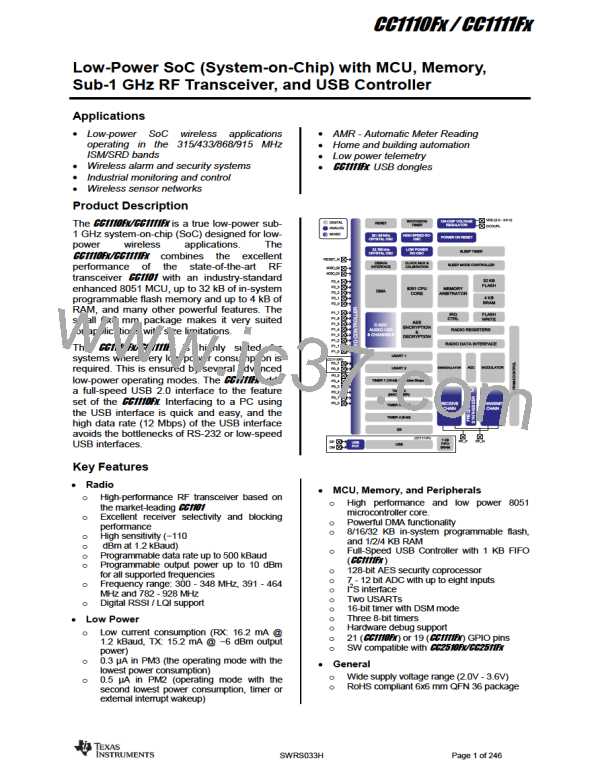CC1110Fx / CC1111Fx
6.5 and 6.6 for characteristics of these
oscillators.
Maximum Data Rate [kBaud]
CLKCON.CLKSPD
GFSK,
MSK
OOK
and ASK
2-FSK
The CLKCON.OSC32Kbit selects the source of
the 32 kHz clock. This bit must only be
changed while using the HS RCOSC as the
system clock source. If CLKCON.OSC32K=1,
changing the system clock source to the HS
XOSC will initiate the calibration of the low
power RC oscillator. The calibration of the low
power RC oscillator is continuously performed
as long as CLKCON.OSC=0 and the device is
in active mode or PM0. The result of the
calibration is a RC clock running at 34.667 - 36
kHz for CC1110Fx and 32 kHz for CC1111Fx.
000
001
010
011
100
101
110
111
500
500
500
500
400
200
100
50
250
250
250
250
250
200
100
50
500
500
500
500
400
200
100
50
The low power RCOSC calibration takes
approximately 2 ms. Except for the initial
calibration (first calibration after the HS XOSC
was set as source for the system clock
Table 49: System Clock Speed vs. Data Rate
12.1.5.3 Low Speed Oscillators (32 kHz
clock source)
(CLKCON.OSC=0)),
a
calibration will be
aborted if one of the following actions is
initiated by SW:
Two low speed oscillators are present in the
device:
a) Switching the clock source for the
system clock from HS XOSC to HS
RCOSC by setting CLKCON.OSC=1
Low speed crystal oscillator (32.768
kHz)
Low power RC oscillator (34.667 - 36
kHz for CC1110Fx and 32 kHz for CC1111Fx)
b) Entering PM{1 - 3}.
If a) or b) is initiated during the initial
calibration, the calibration will complete before
a) or b) will take place (i.e., the HS XOSC will
continue as the clock source for the system
clock for up to 2 ms before the switching takes
place or PM{1 - 3} is entered). If a) or b) is
initiated after the initial calibration has
completed, there will be a delay of typically
130 µs from SW initiates a) or b), until the
calibration is being aborted and the system
clock source is changed or PM{1 - 3} is
entered (see Figure 18).
The low speed crystal oscillator is designed to
operate at 32.768 kHz and provide a stable
clock signal for systems requiring time
accuracy. The low power RC oscillator run at
fXOSC / 750 for CC1110Fx and fXOSC / 1500 for
CC1111Fx, when calibrated. The calibration can
only take place when the low power RC
oscillator is running and the high speed crystal
oscillator is enabled and stable, and is initiated
by selecting the HS XOSC as the clock source
for the system clock (CLKCON.OSC=0). The
low power RC oscillator should be used to
reduce cost and power consumption
compared to the 32.768 kHz crystal oscillator
solution. The two low speed oscillators can not
be operated simultaneously.
Note: During the initial calibration a) or b)
can only be initiated once.
After the initial calibration has completed
and a) or b) is initiated, one must not try to
initiate a) or b) again within the next 130
µs.
By default, after a reset, the low power RC
oscillator is enabled and selected as the 32
kHz clock source. The RC oscillator consumes
less power, but is less accurate than the
32.768 kHz crystal oscillator. Refer to Section
2 ms
2 ms
b
2 ms
a
b
a
HS XOSC selected as
clock source for the
system clcok
CLKCON.OSC=0
130 us
a: SW tries to switch the clock source for the system clock (CLKCON.OSC=1) or
enter PM{1 - 3}
b: System clock source is being switched or PM{1 - 3} is entered
Do not attempt to repeat a) and/or b) during this period
Figure 18: Low Power RCOSC Calibration
SWRS033H
Page 81 of 246

 TI [ TEXAS INSTRUMENTS ]
TI [ TEXAS INSTRUMENTS ]